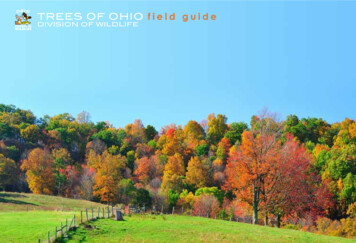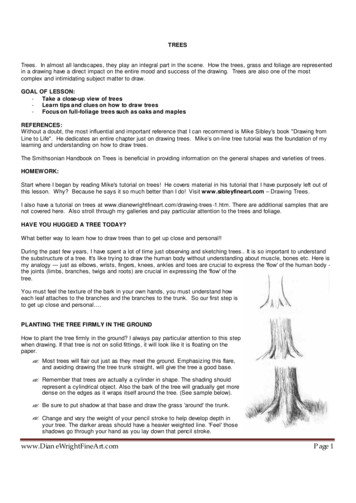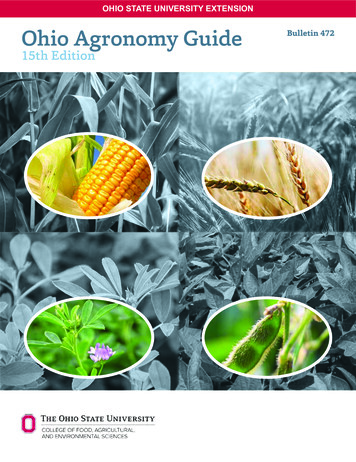
Transcription
TREES OF OHIO f i e l d g u i d eDIVISION OF WILDLIFE
INTRODUCTIONThis booklet is produced by the ODNR Division of Wildlife as a free publication. This booklet is not for resale. Any unauthorized reproduction is prohibited. All images within this booklet are copyrighted by the ODNR Division of Wildlife and its contributing artists and photographers. For additionalinformation, please call 1-800-WILDLIFE (1-800-945-3543).Forests in Ohio are diverse, with 99 different tree species documented. This field guide covers 69 of thespecies you are most likely to encounter across thestate. We hope that this guide will help you appreciate this incredible part of Ohio’s natural resources.HOW TO USE THIS BOOKLETFamily nameTrees are a magnificent living resource. They provideshade, beauty, clean air and water, good soil, as wellas shelter and food for wildlife. They also provide uswith products we use every day, from firewood, lumber, and paper, to food items such as walnuts andmaple syrup. The forest products industry generates 26.3 billion in economic activity in Ohio; however,trees contribute to much more than our economicwell-being.The more we learn about trees, the more we can understand, protect, and enjoy them.Common nameScientific nameDECIDUOUSFAMILY BEECHAMERICAN BEECHFagus grandifoliaOverviewKnown for its spreading canopy and distinctive smoothbark, American beech is a slow-growing tree foundthroughout the state. It is an excellent wildlife tree.Beech nuts are high in protein and fat and eaten bymany birds and mammals. Furthermore, many beechtree trunks are partially hollow and provide excellentden sites for various wildlife, including squirrels, raccoons, and opossums. This native tree can adapt tosoils of variable pH and composition but prefers rich,well-drained soils with constant moisture. While American beech is shade tolerant, it achieves best growth inpartial to full sunlight. It is usually long-lived and free ofproblems, but can be susceptible to beech bark disease,beech leaf disease, and storm damage.LEAF: Alternate and simple with coarse serrations ontheir slightly undulating margins, 2-4 inches long. Fallcolor from yellow-green to a rich golden-brown; oldertrees hold dead leaves throughout winter on lower, interior branches while young trees hold virtually all of theirdead leaves until spring (making them stand out in thewoods in the winter).TWIGS AND BUDS: Buds are long (¾ to 1 inch), narrow,pointed, occurring on outer twigs.FRUIT OR SEED: Fruits are composed of an outer pricklyhusk that splits open in late summer and early autumnto reveal one or two triangular, edible nuts enjoyed bybirds and mammals alike. Beech nuts are known as anexcellent food source for wildlife, high in fat and proteinand produced in large quantities.BARK: Smooth, thin, light to steel gray, that is common-ly carved with initials and graffiti and holds carvings fordecades. Carvings create wounds for disease entry, soplease respect the tree!SHAPE: Short trunk, rounded to spreading.8MATURE HEIGHT: 60-80 feet.TREES OF OHIOTABLE OF CONTENTS02 Introduction04 History of Ohio's Forests05 Importance of Trees06 Broadleaf Types07 Leaves and Limbs08 Species Accounts77 Glossary79 Publication Funding
SPECIES ACCOUNTSDECIDUOUS TREESBEECH FAMILY8 American Beech9 American Chestnut10 Black Oak11 Bur Oak12 Chestnut Oak13 Chinkapin Oak14 Northern Red Oak15 Pin Oak16 Scarlet Oak17 Shingle Oak18 Shumard Oak19 Swamp White Oak20 White Oak BEAN FAMILY21 Black Locust22 Honeylocust23 Kentucky Coffeetree BIGNONIA FAMILY24 Northern CatalpaLINDEN FAMILY35 American BasswoodROSE FAMILY47 Black CherryBIRCH FAMILY25 Black Birch26 River Birch27 Yellow BirchMAGNOLIA FAMILY36 Cucumbertree37 Yellow PoplarTUPELO FAMILY48 Blackgum ELM FAMILY28 Hackberry29 American Elm30 Slippery Elm EBONY FAMILY31 Persimmon HORSECHESTNUT FAMILY 32 Ohio Buckeye 33 Yellow BuckeyeLAUREL FAMILY34 Sassafras MAPLE FAMILY38 Boxelder39 Red Maple40 Silver Maple41 Sugar Maple MULBERRY FAMILY42 Osage Orange43 Red Mulberry OLIVE FAMILY44 Green Ash45 White Ash PLANE TREE FAMILY46 American Sycamore WALNUT FAMILY49 Butternut50 Black Walnut51 Bitternut Hickory52 Mockernut Hickory53 Pignut Hickory54 Shagbark Hickory55 Shellbark Hickory WILLOW FAMILY56 Bigtooth Aspen57 Black Willow58 Eastern Cottonwood WITCHHAZEL FAMILY59 Sweetgum CONIFER TREESPINE FAMILY60 Colorado Blue Spruce61 Norway Spruce62 Eastern Hemlock63 Austrian Pine64 Eastern White Pine65 Loblolly Pine66 Pitch Pine67 Red Pine68 Scotch Pine69 Shortleaf Pine70 Virgina Pine CYPRESS FAMILY71 Eastern Redcedar INVASIVE TREES72 Callery Pear73 Sawtooth Oak74 Siberian Elm75 Tree-of-Heaven76 White Mulberry
THE HISTORY OF OHIO'S FORESTSPrior to European settlement when Ohio’s forests covered 95 percentof the state, it was said that a squirrel could travel from one corner ofthe state to the other without touching the ground. While that maybe an exaggeration, forests of many types were abundant throughout the state. Elm-ash forests were dominant in the northwest Ohioswamp lands and streamside areas; mixed oak-hickory forests dominated the southeast Ohio hill country, and maple-beech forests werecommon in northeast Ohio and much of Ohio’s current farm country.With the historical clearing of forestland followed by natural conversion of old fields back to woods, oak-hickory forests likely expandedtheir distribution. Currently oak-hickory forests are the most commonforest type in the state at around 63 percent of all forests. A broadernorthern hardwood forest type that includes maple and beech is nextin abundance, covering around 20 percent of Ohio’s forestland. Elmash forests are still common in northwest Ohio and along streamsideareas. However, with the introduction of the exotic beetle called theemerald ash borer into Ohio in 2003, most of Ohio’s mature ash treesare dead or dying. The total area of forest land in the state has stabilized in the past two decades at around 30 percent of the total landarea. The majority of forests are in the mid-successional stage and aredominated by trees that are often over a foot in diameter and 50 to90 years old.Significant clearing of forests occurred until the 1940s when only 12percent of the land remained forested. Forest land has expanded tocurrent conditions, where 31 percent of Ohio’s land area is coveredby forests.Virigina-Pitch PineOak-PineOak-HickoryOak-GumElm-Ash-Red MapleMaple-Beech-BirchOpen or mixed land cover
WHY ARE TREES IMPORTANT FOR WILDLIFE?SUCCESSIONAL FORESTSTHE IMPORTANCE OF MASTMany wildlife species are reliant on forests to providethe basic habitat requirements of food, water, shelter,and space. Different species of wildlife require diversehabitat components and are dependent on variousstages of forest succession, or ages, to meet their specific needs. Forests grow as plants develop and agetowards maturity, and each state of succession offersdifferent habitat assets. The early stages of a forest'slife are just as important as the later stages, and provide much needed diversity in habitat.Mast is a term used to describe the fruit of a woodyplant. The fruit is the part of the tree that contain theseeds and protects them until they can sprout in theground. These fruits are categorized as either hardmast or soft mast.Many people believe that older forests provide enhanced habitat opportunities for wildlife, and that thehighest diversity of species would be found in theseareas. While it’s true that mature forests are home tomany species, a variety of forest age-classes will domore to attract a wider diversity of wildlife.Early successional, or young, forests produce an abundance of fruits and seeds, and provide shrub thicketsfor cover which attracts species such us common yellowthroats, eastern towhees, and bobcats. Mid-successional, or mid-aged, forests support species thatuse a wide range of habitats such us wild turkeys,indigo buntings, and white-tailed deer. Mature, orolder, forests produce more acorns and nuts and provide snags and tree cavities for nesting which attractsspecies such us flying squirrels, pileated woodpeckers, and silver-haired bats. Even open areas with littlewoody vegetation produce seeds and insects for wildlife and provide herbaceous food and cover which attracts species such us eastern cottontail rabbits, fieldsparrows, and prairie warblers.Hard mast are seeds with a hard outer covering, suchas acorns, hickory nuts, and walnuts. Hard mast is animportant food source for wildlife because it does notdecay quickly, thus providing animals with nutritionthroughout the winter. It is a good source of proteinand fat which are important nutritional components.Trees require a large amount of energy to create hardmast, so they generally only produce a substantialcrop every few years. Many wildlife species consumeacorns, including some you might not think of, such asfoxes and ducks. Oak-hickory forest is the most widespread forest type in Ohio and is an important habitatin the eastern U.S. However, poor oak regeneration inrecent years is a cause for concern.Tree species such as maple, poplar, and beech are increasing in abundance. These species grow faster thanoaks and do not require as much sunlight, shading outsmaller trees. Maples and poplars produce a fruit thatis classified as soft mast, meaning it has a soft outercovering and decays quickly. It is usually high in sugarand carbohydrates which are not as important nutritionally. This makes it an unreliable food source duringthe winter, but it does serve as a good short-term energy source for migrating wildlife that pass throughOhio. Trees don’t use as much energy to produce softmast, so it is more readily abundant every year.SQUIRRALBY NINA HARFMANN
BROADLEAF TYPESOne of the most important tree identificationconcepts is leaf and branch arrangement. All ofOhio’s trees can be placed into one of three categories: alternate, opposite, or whorled. In analternate leaf and branch arrangement, thereis one leaf or branch per plant node, and theyalternate sides. In an opposite leaf and brancharrangement, two leaves or branches arise fromthe same node on opposite sides of the stem.Most Ohio tree species have alternate arrangement. To remember the few tree species thathave opposite arrangement, use the mnemonicof MAD BUCK (maple, ash, dogwood, and buckeye). Another important concept is differenti-SIMPLESIMPLECatalpaBROADLONGER THAN WIDESMOOTHSMOOTHNOT LOBEDBlackgum, PersimmonCucumbertreeSIMPLETOOTHEDBeech, Chestnut, Hackberry,Elm, Birch, Black Cherry, WillowLOBEDOaksA LT ELOBEDCOMPOUNDBROADLEAFOPPOSITEAspen, Basswood,Cottonwood,Mulberry,Callery PearYellow Poplar,Sassafras,Sycamore,SweetgumWHORLEDR N ATEOsage Orangeating between simple and compound leaves.Simple leaves have a single leaf blade, whilecompound leaves consist of multiple leaflets.Once you have determined if a tree has alternate, opposite, or whorled leaf and branch arrangement, you can use the broadleaf diagramon the following page to further identify leaves.LOBEDMaplePINNATECOMPOUNDBIPINNATEAsh, Boxelder,Tree-of-HeavenHickory, Walnut, Black LocustHoneylocust, Kentucky CoffeetreePINNATEPALMATEBuckeye
LEAVES & LIMBSSHAPESMARGINSARRANGEMENTEntireeven, smooththroughoutLobeddeeply indented marginsOppositeSpinyteeth sharpstiff pointsPalmateresembles a handAlternateDoubly Serrateserrate with sub-teethOdd Pinnateleaflets in rows, one at tipBipinnateleaflets also pinnateSerrateteeth forward-pointingWhorled
DECIDUOUSFAMILY BEECHAMERICAN BEECHFagus grandifoliaKnown for its spreading canopy and distinctive smoothbark, American beech is a slow-growing tree foundthroughout the state. It is an excellent wildlife tree.Beech nuts are high in protein and fat and eaten bymany birds and mammals. Furthermore, many beechtree trunks are partially hollow and provide excellentden sites for various wildlife, including squirrels, raccoons, and opossums. This native tree can adapt tosoils of variable pH and composition but prefers rich,well-drained soils with constant moisture. While American beech is shade tolerant, it achieves best growth inpartial to full sunlight. It is usually long-lived and free ofproblems, but can be susceptible to beech bark disease,beech leaf disease, and storm damage.LEAF: Alternate and simple with coarse serrations ontheir slightly undulating margins, 2-4 inches long. Fallcolor from yellow-green to a rich golden-brown; oldertrees hold dead leaves throughout winter on lower, interior branches while young trees hold virtually all of theirdead leaves until spring (making them stand out in thewoods in the winter).FRUIT OR SEED: Fruits are composed of an outer pricklyhusk that splits open in late summer and early autumnto reveal one or two triangular, edible nuts enjoyed bybirds and mammals alike. Beech nuts are known as anexcellent food source for wildlife, high in fat and proteinand produced in large quantities.TWIGS AND BUDS: Buds are long (¾ to 1 inch), narrow,ly carved with initials and graffiti and holds carvings fordecades. Carvings create wounds for disease entry, soplease respect the tree!pointed, occurring on outer twigs.BARK: Smooth, thin, light to steel gray, that is common-SHAPE: Short trunk, rounded to spreading.8MATURE HEIGHT: 60-80 feet.
DECIDUOUSFAMILY BEECHAMERICAN CHESTNUTCastanea dentataFormerly a common mature forest tree across easternOhio, American chestnut was devastated by the chestnut blight disease. Most American chestnuts foundin the wild today are sprouts from old chestnut treesthat died back from the blight and sprouted from thestumps, a cycle that has been repeated multiple timesover the years. Breeding programs have introducedblight-resistance genes from Asian chestnuts into resistant strains of American chestnut with some success,but its uncertain when large-scale reintroduction intoforests will become an option. Historically, it preferredmoist, deep, acidic soils in full sun. Its nuts were oncea staple food of the Native Americans, pioneers, and adiversity of wildlife. It has rot-resistant wood that washarvested to produce a variety of products from furniture to construction lumber.LEAF: Alternate, smooth surface, simple, 5-9 incheslong, elliptical to oblong in shape, with sharp-pointedtips and sharply pointed teeth on margins. Fall color isyellow, gold, or brown.TWIGS AND BUDS: Stout, hairless, orange brown in col-or. Buds are orange-brown and measure up to ¼ inchlong. Terminal buds are singular, not clustered like oaks.FRUIT OR SEED: Large, round, prickly husks containingseveral shiny chestnut-brown nuts that are flattened onone or two sides. Husks split open in autumn and exposed nuts are eaten by wildlife.BARK: Young bark is smooth, shiny, and olive-brownwith prominent lenticels. Mature bark is dark graybrown and thick with shallow irregular furrows separating broad flat-topped shiny ridges.SHAPE: Once a tall and excellent formed tree, Americanchestnut is now found mostly as small stump sprouts.9MATURE HEIGHT: 80 feet (historically, prior to blight).
DECIDUOUSFAMILY BEECHBLACK OAKQuercus velutinaThe native black oak is present throughout almost allof Ohio but is most frequently found in Appalachianfoothills and sandy ridges near Lake Erie. This deeplytaprooted oak prefers full to partial sun and moist, deep,well-drained acidic soils but can also excel in poor, drysoil sites. Commonly confused with northern red oak,these trees are basically problem-free other than minorcosmetic damages from insect feeding.LEAF: Dark green, alternate, 4-9 inches long, and moderately shiny, broadly obovate, with five to nine lobesthat have bristles terminating each tooth on the forward-pointing lobes. Underside of leaves are commonlyhairy. Sinus depth is variable, with some leaves displaying shallow sinuses and others with deep sinuses. Fallcolor ranges from yellow to brick red.FRUIT OR SEED: Acorns, about ¾ inch long, are oval orrounded, slow to mature, and enclosed for about half ofits length in a deep, loosely scaled, bowl-shaped cup.TWIGS AND BUDS: Twigs terminate in a cluster ofSHAPE: Taller or more dwarfed depending on location,light-colored pubescent budssmooth to pubescent twigs.onreddish-brownFLOWER: Monoecious, small golden catkins.10BARK: Mature bark of black oak is dark gray to nearblack and divided into broad, furrowed ridges. The innerbark is bright orange or yellow.crown is usually rounded.MATURE HEIGHT: 50-80 feet.
DECIDUOUSFAMILY BEECHBUR OAKQuercus macrocarpaThe bur oak is a massive, slow-growing tree foundthroughout Ohio except for some southeastern counties. It is adaptable to both moist and dry sites and often found standing by itself. The bur oak is one of themost picturesque of the oaks. Its fiddle-shaped leatheryleaves, huge-fringed acorns, thick and sometimes corkytwigs, and deeply ridged, fire-resistant bark add to itsbold texture.LEAF: Textured, leathery leaves that are 4-12 incheslong and 3-6 inches wide, alternate, teardrop shaped,and usually dark green. Leaf shape varies significantlybut consists of about five to nine lobes of different sizes. Lower lobes are small, the central lobes average, andthe upper lobes are large with crenate margins. Centerpair of sinuses extend nearly to the mid-rib. Fall color isusually yellow to yellow-brown, but leaf drop is usuallycomplete.FRUIT OR SEED: Large acorns are oval or broadly ovate,broad at the base, and rounded at the depressed apex.The acorn is up to 1½ inches long and nearly covered bya rough, frilled cap.TWIGS AND BUDS: Branchlets are sometimes corky,BARK: Mature bark becomes highly ridged and deeplywhile at other times moderately rough, but non-corky.Clustered terminal buds are blunt and often large, occurring on its stout twigs.furrowed with dark gray color that is characteristic of thewhite oak group.SHAPE: Pyramidal to oval.MATURE HEIGHT: 70-90 feet.11
DECIDUOUSFAMILY BEECHCHESTNUT OAKQuercus montanaThis oak is found in eastern and southern Ohio, in theunglaciated Appalachian highlands. The slow-growing chestnut oak is named due to its resemblance tothe American chestnut tree. Because this species is asource of tannin extract (an organic substance used inleather production), this tree is also known as the tanbark oak. This native tree grows best in full to partial sunand moist, well drained, acidic soils; however, is highlyadaptable and can often be found growing in poor,rocky, dry soils of alkaline or neutral pH.LEAF: Dark green and leathery, 4-8 inches long, alternate and obovate. They are roughly oval but often widernear the apex with large, rounded teeth. Leaf undersidesare medium-green and often hairy.TWIGS AND BUDS: Stout twigs with rapidly accumulat-ing bark; large, jagged, and pointed terminal buds thatare clustered.FRUIT OR SEED: Acorn is shiny, large, oval-shaped,and takes only one season to develop. The cup is thin,covered with fused scales, and attached to branches bylong peduncles.12BARK: Its unique light to medium gray mature barkfeatures triangular ridges with deep furrows in between them.SHAPE: Variable, can be pyramidal to oval to rounded.MATURE HEIGHT: 70-100 feet.
DECIDUOUSFAMILY BEECHCHINKAPIN OAKQuercus muehlenbergiiThis native oak is most common in the limestone soilsof southwest Ohio, but scattered in other areas exceptin the northeastern corner of the state. Also known assweet oak or chinquapin oak, its small acorns draw a variety of wildlife including wild turkeys, deer, chipmunks,and squirrels. Historically, its durable wood was used forsplit-rail fences and railroad ties. Chinkapin oak adaptsto many soil conditions but prefers moist, well-drained,deep, rich, alkaline soils and full to partial sun.LEAF: Glossy alternate, oblong to slightly obovate, 4-6inches long with margins that may be deeply or shallowly crenate. Fall color is usually yellow to yellow-brown;leaf drop is usually complete in late autumn.BARK: Immature bark is light gray and ranges from flakyTWIGS AND BUDS: Small, clustered terminal buds areSHAPE: Spreading.orange-brown and sharp pointed on slender twigs.FRUIT OR SEED: Acorns are small, up to ¾ inch in size,and mature in one season, with a thin, bowl-shapedwarty cap covering half the nut and a smooth inner lining that looks like a shiny bowl. Acorns are known as thesweetest of Ohio’s oaks.13to platy. Mature bark has ridges that break into light grayblocks and are separated from dark gray deep furrows.Bark flakes off easily when rubbed.MATURE HEIGHT: 60-80 feet.
DECIDUOUSFAMILY BEECHNORTHERN RED OAKQuercus rubraNorthern red oak is important to the Ohio timber industry, providing strong hardwood used in the production ofbeams, railroad ties, furniture, flooring, and more. A popular shade and ornamental tree, northern red oak is notedfor its distinct red-brick autumn foliage and rapid growthrate. Northern red oak acorns mature earlier in the seasonthan most oaks and are enjoyed by many forms of wildlife as a result. Northern red oak prefers moist, deep, rich,well-drained soils of slightly acidic pH and full to partialsun. Other than cosmetic blemishes from insect feeding,this native oak is basically problem-free.LEAF: Broadly teardrop shaped with seven to 11 bris-FRUIT OR SEED: Acorns are ¾ to 1¼ inches long; the cupTWIGS AND BUDS: Terminal buds are clustered. Twigsare greenish or reddish brown, smooth when mature.Buds are pointed, light brown, and smooth.BARK: Immature bark is smooth and light gray, maturingtle-tipped lobes, 4-9 inches long, up to 6 inches wide withsmooth surface, dull green above but paler with smalltufts of reddish-brown hair in vein-axils beneath. Sinusdepths vary between trees from shallow to nearly mid-rib.shallow, saucer shaped, covering ¼ of the nut. Scales reddish-brown, narrow, tight, and sometimes fuzzy on theedges. The acorns develop over two growing seasons,ripening in early summer and late autumn.to dark gray or nearly black with shiny flattened ridgesresembling ski tracks.SHAPE: Rounded.MATURE HEIGHT: 70-100 feet.14
DECIDUOUSFAMILY BEECHPIN OAKQuercus palustrisOften seen in moist lowlands and wetlands, the pin oakis known for its strong wood, dense shade, and distinctive branching. Pin oak has persistent dead brancheswith the lower branches angled down. Generally, thisnative tree requires moist and acidic soils with full topartial sun for optimum growth. Pin oak suffers from leafchlorosis if transplanted in neutral or alkaline soils. Pinoaks can also suffer from insect galls and other pathogens that afflict oaks.LEAF: Glossy, dark green leaves that are 3-6 inches longwith five lobes separated by very deep sinuses.BARK: Thin, slightly ridged and shallowly furrowedTWIGS AND BUDS: Terminal buds are small and in clus-SHAPE: Somewhat conical with the lower branches an-FRUIT OR SEED: Acorns that are nearly round and ½inch long with a thin, saucer-shaped cup made of small,tight scales. Acorns are eaten by songbirds, deer, wildturkeys, squirrels, rodents, and ducks.MATURE HEIGHT: 70-100 feet.ters on reddish brown twigs.15when young; dark gray to gray-brown in maturity.gled downward.
DECIDUOUSFAMILY BEECHSCARLET OAKQuercus coccineaNamed for its brilliant fall colors, scarlet oak is foundabundantly on dry sites in eastern and southern counties but is rare elsewhere. This fast-growing native treeprefers dry, acidic soils and full to medium sun; it willnot perform well in soils of neutral or high pH and maydevelop chlorosis (yellowing of leaf blades). Scarlet oakacorns are an important food source for many songbirds, wild turkeys, squirrels, and deer.LEAF: Alternate, broadly elliptical, 4-7 inches long to 5inches wide, with toothed and pointed lobes. Sinusesvary in depth and width, even on the same tree. Deepsinuses cutting nearly to mid-rib with narrow, bristle-tipped lobes are common in the upper part of thetree canopy.TWIGS AND BUDS: Twigs terminate in a cluster of budswith varying size and degree of pubescence, rangingfrom small on grayish-green twigs to large and hairy onreddish-brown twigs.16FRUIT OR SEED: Acorns are ½ to 1 inch long, oval, andenclosed to about ½ of their length in a deep, bowlikecup. They often have concentric rings resembling abull's-eye on the exposed acorn tips.BARK: Thin bark becomes moderately ridged and shallowly furrowed with age and is dark gray to gray brownin color.SHAPE: Pyramidal to rounded.MATURE HEIGHT: 60-90 feet.
DECIDUOUSFAMILY BEECHSHINGLE OAKQuercus imbricariaThe narrowly split wood of this native tree was historically used by pioneers to make shingles, resulting in itscommon name. Shingle oak is scattered throughout thestate, found in a variety of environments, and adapts to avariety of sites. Its canopy is often broad-spreading at maturity, and it is the only oak native to Ohio that has simple,non-lobed leaves with entire margins. Shingle oaks prefermoist, well-drained, acidic soils and full to partial sun, butadapts well to relatively poor, dry soils of neutral or slightly alkaline pH. These trees will get a slight amount of leafchlorosis in very high pH soils and are subject to the usualarray of pests and pathogens that can affect many oaks,including borers, galls, gypsy moth, and leaf scorch.LEAF: Unlike most oaks, leaves are unlobed, 4 to 6 incheslong, alternate, simple, shiny and leathery, elliptical to oblong, terminated by a single bristle tip. Fall color is usuallyyellow to reddish-brown and many leaves may persist inthe interior canopy throughout the winter.TWIGS AND BUDS: Twigs terminate in a cluster of egg-shaped buds covered with closely overlapping lightbrown scales. Twigs often have noticeable woody galls.FRUIT OR SEED: Acorns take two years to mature. Theyare rounded, about ½ inch long, and topped with a thin,reddish-brown cap enclosing the top of the nut.BARK: Thin immature bark becomes ridged and fur-rowed with age; dark gray to gray brown in color. Wood isdistinctly red-orange when cut or split.SHAPE: Broad-spreading.MATURE HEIGHT: 60-80 feet.17
DECIDUOUSFAMILY BEECHSHUMARD OAKQuercus shumardiiShumard oak occurs sporadically in the western half ofOhio, often growing in ravines, upper floodplains, andalong streams. Its small acorns are consumed by wildlifesuch as squirrels and deer. Shumard oak is an excellenturban shade tree due to its adaptability, rapid growth,and tolerance of air pollution and compacted soil. Thisnative tree prefers moist, well-drained deep soils of variable pH and full to partial sun but can tolerate very dryand alkaline soils. Other than minor cosmetic blemisheson foliage due to insect feeding, Shumard oak is basically problem-free.LEAF: Alternate, simple, 4-7 inches long, broadly ovate,and shiny with seven to nine lobes with coarse bristletips and sinuses that are normally deep. Fall color rangesfrom russet to orange-red in good years.FRUIT OR SEED: Acorns are single or paired, ¾ to 1¼inches long, oblong and ovoid. The top of the acorn iscovered with a shallow, bowl-shaped, scaly cap.TWIGS AND BUDS: Olive-green, stout twigs terminate intive in winter sun. Mature bark is ridged, furrowed, anddark gray in color.a cluster of light-colored, smooth, or slightly fuzzy buds.FLOWER: Both male and female flowers are found onthis tree in mid-spring, giving it the ability to self-fertilize. Fertilized flowers take two years to develop intomature acorns.18BARK: Immature bark is light gray, smooth, and reflec-SHAPE: Pyramidal and spreading.MATURE HEIGHT: 60-90 feet.
DECIDUOUSFAMILY BEECHSWAMP WHITE OAKQuercus bicolorThe swamp white oak can be found throughout mostof the state, though not abundant in southeastern Appalachian counties. As its name would suggest, swampwhite oak can frequently be found growing in swamps,wetlands, and near bodies of water although it is verydrought tolerant. It prefers rich, moist to wet, poorlydrained acidic soils and full to partial sun. Its wood is indistinguishable from white oak when cut and could beused for the same purposes, including lumber, flooring,furniture, and timber. However, swamp white oak treesoften have inferior quality to white oak.LEAF: Obovate, alternate, 4-7 inches long with deepcrenate margins. The undersides are white. By the end oflate summer, the leaves commonly develop a powderymildew. In the fall the leaves turn a crimson color.FRUIT OR SEED: Acorns develop in a single season andripen in early to mid-autumn, usually in pairs on a long,thick stalk (1 to 3 inches), or stem. Acorns are oval with asmall, scaly cup and ripen in early to mid-autumn.TWIGS AND BUDS: Terminal buds are clustered andvery small. Branchlets are flaky and develop distinctflares of bark.BARK: When bark is mature it is ridged and furrowedFLOWER: Monecious with pollen-bearing catkins thatdevelop in the mid-spring.19giving off a light gray color.SHAPE: Open, round-topped.MATURE HEIGHT: 60-80 feet.
DECIDUOUSFAMILY BEECHWHITE OAKQuercus albaThis large native tree is one of the most important hardwoods found in Ohio and features some of the best fallcolors among oaks. Its strong, waterproof wood is usedfor lumber, railroad ties, flooring, and furniture. Whiteoak wood is also favored for barrel production. Whiteoak acorns are a popular food source for wildlife, and areeaten, stored, and gathered by rodents, birds, and deer.Found in a range of habitats across the state, the whiteoak prefers full sunlight and deep, well drained, acidicto neutral soil.LEAF: Alternate, slightly obovate, 5-9 inches long. Leafshape is highly variable but often narrows at the base tocreate a wedge shape at the stem and consists of sevento nine finger-like rounded lobes. Lobes differ greatly intheir width and length.BARK: Highly variable bark may be ridged, deeply fur-TWIGS AND BUDS: Buds are small and rounded, with acluster of relatively large terminal buds.MATURE HEIGHT: 70-100 feet.FRUIT OR SEED: Acorns are about 1 inch long, chestnut-brown and enclosed at the end in a bowl-shaped,warty-scaled cup with a stalk.20rowed, have sma
cies documented. This field guide covers 69 of the species you are most likely to encounter across the state. We hope that this guide will help you appre-ciate this incredible part of Ohio’s natural resources. Trees are a magnificent living resource. They provide shade, beauty, clean air










